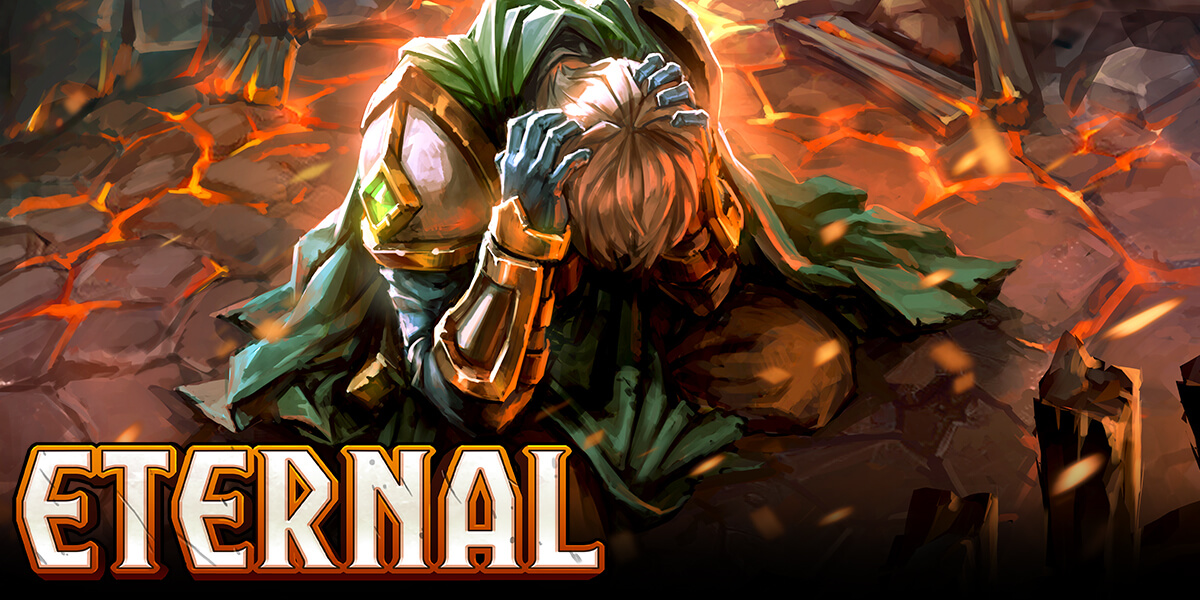We recently published an opinion piece about Elder Scrolls: Legends. The game has garnered some traction and has a very loyal following. I was one of those followers as well, enjoying the change from some of the other offerings like Hearthstone, but missing some of the more traditional aspects that I grew up with as a Magic: the Gathering player since the days of Alpha. Then I noticed that Direwolf Digital was also working on a title called Eternal. Side note Pokemon fans, they also handle the digital version of that card game as well. So what drew me to Eternal? First, Luis Scott-Vargas, or LSV to the Magic community, was just one of the individual that helped design the game. LSV and a few others are Hall of Fame, or extremely successful, Magic players that I have followed since they came on the scene Magic scene.
As someone that played some tournament Magic in my life, and spent a majority of my time brewing decks and hanging out at card shops playing, I always wondered what could be done to make Magic a better game. Then the digital card game revolution started with Magic Online, then Hearthstone, and a slew of mobile titles. I knew that at some point, someone would get in and “fix” Magic. That isn’t to say that M:tG is a bad game. The design is beautiful, but there were some limitations placed early on in its life. Limitations that have some actual benefits. The luck aspect, for one, lets you take a loss easier by saying you got “mana screwed”, or didn’t draw your key cards, which is a huge benefit for newer players and reduces the chance of table flipping by more experienced players.

Eternal uses many of the same ideas that made Magic great but takes advantage of the fact that it is a digital game. Now, instead of having a table full of different lands for your mana (the stuff that lets you play), you simply have power cards that give you a certain threshold of that specific type of power. The color wheel, Black, White, Blue, Red, and Green is still in tact, though the shades and names are different, but the mana system works similarly, though has key differences. You don’t get one power (mana) each turn, you have to balance your power base within your deck. Another thing that Magic has going for it is the deck size. At 60 cards, you can build a combo deck that can be pretty consistent. Ask anyone that played my old Chronotag deck back in the day. With Eternal, the deck size is now 75. Those extra 15 cards give just enough of a buffer to keep decks from consistently combo-ing off, though there are already decks that are consistently taking advantage of certain cards. (I’ll likely stream one of my fun almost infinite decks soon).
Many of the other rules are similar to the competition, though. Combat is handled by the attacker choosing all attacking cards at once, and the defender blocking as they see fit. Spells can be played on the other players turn if they have certain keywords, and big spells can be thrown right at the other players face. But there are some key differences that only a digital card game can pull off. One is that stat changes on cards persist through zones. For example; if you have a creature in Magic that has a +1/+1 buff on it and it changes zones (either going to your hand or the graveyard) it loses those bonuses. In Eternal, it stays. There are also interesting mechanics, such as “revenge” which puts the card with the keyword within the top 10 cards of your deck instead of going to the graveyard and when it is drawn it immediately gets played for free and you draw another card. This can lead to some broken decks, but there are always safety valves out there if the meta gets too out of hand, such as cards that can remove text from all the cards in play.

But Eternal is Free-to-Play (or Pay-to-Win), Right?
I thought that Eternal was going to be a fun card game to play on occasion, as most free-to-play titles are very unforgiving for those that don’t spend much money to gain advantages. That is completely opposite here. Eternal includes 100 puzzles that teach you about the mechanics of the game and when you complete each puzzle you are rewarded with gold. There is also a campaign, which includes plenty of rewards, and introduces you to some of the lore of the game. For players just getting into the game, the gauntlet lets you play against a series of randomly selected AI decks that, again, reward you with gold. Finally, casual play is great for figuring out how your deck is doing against others without the pressure of ranked play. Then you have Ranked, which gives you rewards at the end of each month based on your ranking. Forge and Draft, which both cost gold to enter round things out. Forge cost 2,500 gold and lets you pick 25 cards that become your deck to play against the AI. If you make it to the end of the Forge run, expect to net about 500 gold more than you spent and 4 packs of cards. The cards you picked are yours to keep as well. Draft costs twice as much as Forge but gives you a bit more freedom in what you choose and what you put in your deck. You also pick cards from 4 packs that are passed back and forth.
Once you create a draft deck, you play real players for rewards. The beauty of how Eternal works is that you get daily quests with varying rewards that can be completed in draft, ranked, casual, or AI modes, depending on the quest. On top of that, each win in ranked Rewards you with a chest that can randomly become a higher tier chest, which includes gold, cards, and packs. Making 5,000 gold doesn’t take many games if you are chasing quests and have a deck that can win a reasonable amount of time. Eternal also hosts events over the weekend from time to time, which have special rules and push players to come up with new ideas for decks and shows that the developers are actively involved in the community of the game. Visit the Discord channel for proof. It can be hard at times to keep up with everything that is being discussed because the community behind Eternal is fairly tight-nit.

To top it all off, you can destroy any cards you get to gain “Shiftstone” which then lets you create any card in the game. I personally save these up for a new set, or to buy the foil version of cards I use frequently. Quite often, Dire Wolf also releases a new card that you can earn 4 of just by winning a match each day. They give you plenty of time to earn the card and make it craftable after it is done with the initial release, so players are never locked out of exclusives.
Now To Get Untechnical
I’ve been pretty technical about the game so far, and that is partly to let players of other card games know what to expect. What I will say is this, the game is only getting better. There are a few hiccups with balance here and there, and at times, everyone is playing the same deck, but the team addresses those issues quickly. The game does a fantastic job of teaching you how to play and getting you started so you can get competitive quickly, and you are never pressured into purchasing anything. Eternal has beautiful art, an active community, genius mechanics, and smooth gameplay. This is the collectible card game to watch. You can find it on iOS, Android, and PC right now.



























































